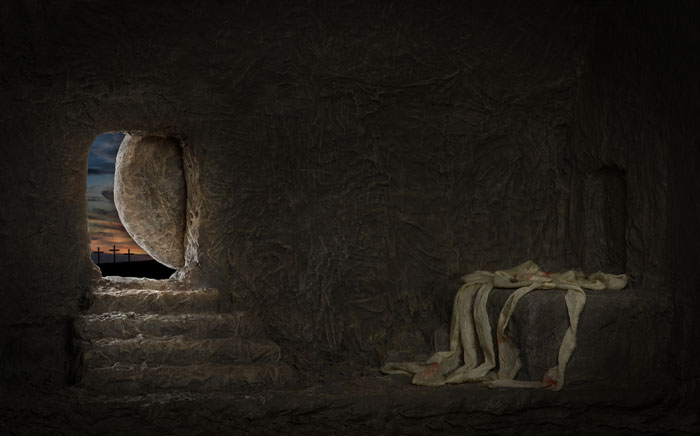Did Jesus Really Rise From the Dead? Are Alternate Theories Put Forth By Non-Believers Plausible?
The Bible says that if Jesus did not rise from the dead then the Christian faith is worthless (1 Cor. 15:17). However, if Jesus did rise from the dead then we know Jesus can keep his promise to give everyone who follows him eternal life (1 John 2:25).
But how can we know that Jesus really rose from the dead and that the Bible’s description of this miracle wasn’t just a story someone made up?
One way is by showing that the Resurrection is the only explanation for the events surrounding Jesus’ death, events that almost everyone, including skeptics, agrees are historical.
As we examine some of the various theories put forward to explain these facts, you will see that only one theory explains 1) Jesus’ death by Crucifixion; 2) his empty tomb; 3) the post-Crucifixion appearances to the disciples; and 4) the disciples’ willingness to die for their faith: the theory that Jesus actually rose from the dead.
The Swoon Theory
One way to explain these facts would be to posit that Jesus never really died. Maybe he just passed out on the cross and woke up in a tomb. Jesus then met up with the disciples who mistakenly thought he’d risen from the dead.
But even if Jesus somehow survived the Crucifixion, the apostles would never have thought he’d miraculously risen from the dead. Upon seeing his bloody, mutilated body, they would have thought Jesus had cheated death, not beaten it, and quickly gotten him medical treatment.
The Trash Theory
How do we know Jesus wasn’t just thrown into an anonymous grave and was forgotten until the disciples imagined they saw him alive again?
Deuteronomy 21:22-23 prohibited the Jewish people from leaving a criminal hanging on a tree, so Jesus would have to have been buried immediately after he died on the cross.
The Gospels say Joseph of Arimathea, a member of the council that condemned Jesus to death, buried him (though John 3:1-2 tells us Joseph was a disciple of Jesus, but in secret, out of fear of the other Jewish leaders).
If the Gospel writers had invented the story of Jesus being buried in a tomb, they would have given their leader an honorable burial at the hands of his friends and family.
This means we have good historical evidence that after the Crucifixion Jesus’ body was placed in an identifiable tomb and simply didn’t vanish in a common graveyard.
The Hallucination Theory
Most historians agree the disciples thought they saw the risen Jesus. The story of Jesus appearing to them was not a legend that developed centuries later but was recorded by the apostle Paul (1 Cor. 15:3-7). It is almost universally recognized among historians that Paul existed, we have the letters he wrote, and Paul knew the people who claimed to have seen the risen Jesus (Gal. 1:18-19).
But could those experiences have just been hallucinations brought on by the terrible grief these men endured after Jesus was executed?
First, it is individuals, not groups, who almost always experience hallucinations. Multiple biblical authors confirm that groups of Jesus’ disciples claimed to see him after his death (Luke 24:36-49, 1 Cor. 15:5-6).
As psychologist Gary Collins writes, “By their very nature only one person can see a given hallucination at a time. They certainly aren’t something which can be seen by a group of people.”
Second, the theory that Jesus’ depressed disciples hallucinated his Resurrection doesn’t explain why enemies of the Church came to believe in the Resurrection. The most famous example would be St. Paul, who was a Jewish leader who persecuted the Church until an encounter with the risen Christ moved him to join the “Jewish heresy” he had been persecuting.
The best explanation for such a sudden conversion is that Paul had a real encounter with the risen Christ.
The Empty Tomb
We’ve already seen that it is historically certain Jesus was buried in a locatable tomb. The Gospels tell us that on the Sunday after the Resurrection a group of women discovered the tomb was empty. But why should we believe Jesus’ tomb was empty and that the authors of the Gospels didn’t make this up?
First, the disciples preached the empty tomb in the city of Jerusalem. If the tomb were not empty, enemies of the early Church could easily have taken the body out of the tomb and proven Jesus did not rise from the dead.
Second, the earliest enemies of the Church agreed that Jesus’ tomb was empty. Matthew’s Gospel says the Jewish leaders of his day (about forty to fifty years after the Crucifixion) believed Jesus’ body was stolen from the tomb (Matt. 28:11-15). The second-century Christian writer St. Justin Martyr also says that the Jews of his time believed Jesus’ body was stolen.
Finally, the Gospels include the testimony of women discovering the tomb. In Jesus’ time a woman’s testimony was considered to be as reliable as that of a child or a criminal. If the Gospel authors had invented the story about Jesus’ tomb being found empty, they would have used trustworthy characters like Peter or John. The embarrassing detail about women discovering the empty tomb was included in the story simply because that’s what really happened.
The Fraud Theory
Is it possible the disciples stole Jesus’ body and then told people their Messiah had risen from the dead? It’s not impossible, but this theory seems extremely unlikely.
Moreover, fraud is normally committed for personal gain; the only thing the disciples had to gain from their fraud was persecution and death. Since people don’t knowingly die for a lie, we can be confident Jesus’ disciples really believed in the Resurrection they preached to others.
There is no chance they were all deceived or that they all chose to die painful deaths in order to deceive others. What’s more likely is that Jesus’ Resurrection really happened and gave them the courage to share this good news in the face of persecution. They knew that even if they were to die through Christ they would live forever. We too can have eternal life if we trust in God’s promises and choose to be baptized into the Resurrection of Jesus Christ (Rom. 6:3-5).
Why We Believe: The Resurrection
**Even skeptics admit that Jesus was crucified, buried, his tomb was found empty, his disciples saw him after his death, and they were willing to die for that truth.
**Other explanations, like hallucination or fraud, only explain some of these facts.
**The most plausible explanation for all these facts is that Jesus really did rise from the dead
Did you enjoy this excerpt from Why We're Catholic?
You can order your single copy of Why We're Catholic for only $13.95 a copy - Better yet, you can partner with us to help get the word out and order a case of 20 for $60 - That's $3 a copy.
Recent Posts
-
If We Just Love Jesus, Does It Really Matter Which Church We Go To?
When I was considering joining the Catholic Church, I sat down with some of my non-Catholic friends …Dec 12th 2025 -
How Can I Prepare Myself to Receive Holy Communion at Mass More Fruitfully?
Preparation for the celebration of the holy Mass and reception of Holy Communion is an essential el …Dec 8th 2025 -
Why Does the Church Celebrate "Seasons"?
Liturgical seasons are days and weeks set aside on the Church calendar for ongoing celebration of e …Dec 1st 2025










